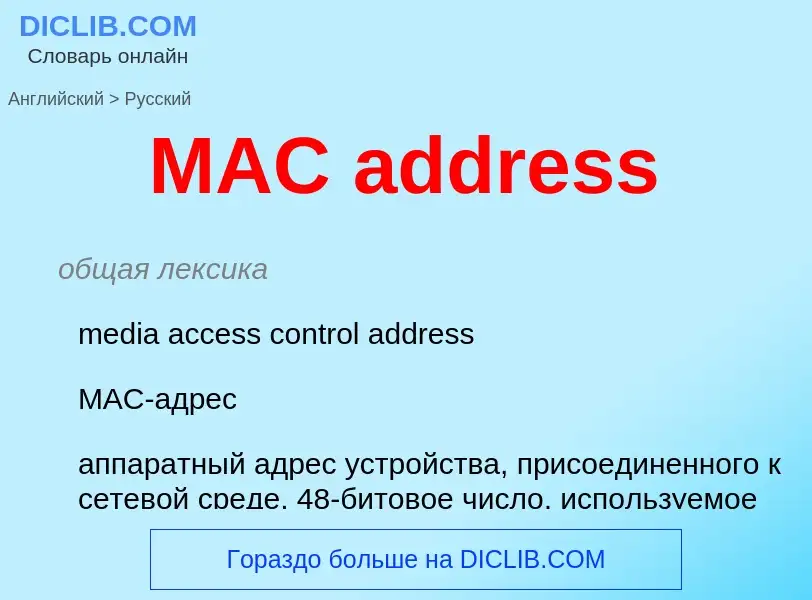Перевод и анализ слов искусственным интеллектом ChatGPT
На этой странице Вы можете получить подробный анализ слова или словосочетания, произведенный с помощью лучшей на сегодняшний день технологии искусственного интеллекта:
- как употребляется слово
- частота употребления
- используется оно чаще в устной или письменной речи
- варианты перевода слова
- примеры употребления (несколько фраз с переводом)
- этимология
MAC address - перевод на Английский
общая лексика
media access control address
MAC-адрес
аппаратный адрес устройства, присоединенного к сетевой среде. 48-битовое число, используемое системой доступа к среде, позволяющее однозначно идентифицировать устройство в локальной сети
Смотрите также
общая лексика
Macro
файл с макрокомандами (напр., в пакете ACCEL EDA)
файл с исходным текстом программы на макроассемблере
файл с изображением в формате ПК Macintosh (в MacPaint)
файл с проектом Visual Basic
Определение
Википедия
A media access control address (MAC address) is a unique identifier assigned to a network interface controller (NIC) for use as a network address in communications within a network segment. This use is common in most IEEE 802 networking technologies, including Ethernet, Wi-Fi, and Bluetooth. Within the Open Systems Interconnection (OSI) network model, MAC addresses are used in the medium access control protocol sublayer of the data link layer. As typically represented, MAC addresses are recognizable as six groups of two hexadecimal digits, separated by hyphens, colons, or without a separator.
MAC addresses are primarily assigned by device manufacturers, and are therefore often referred to as the burned-in address, or as an Ethernet hardware address, hardware address, or physical address. Each address can be stored in hardware, such as the card's read-only memory, or by a firmware mechanism. Many network interfaces, however, support changing their MAC address. The address typically includes a manufacturer's organizationally unique identifier (OUI). MAC addresses are formed according to the principles of two numbering spaces based on extended unique identifiers (EUIs) managed by the Institute of Electrical and Electronics Engineers (IEEE): EUI-48—which replaces the obsolete term MAC-48—and EUI-64.
Network nodes with multiple network interfaces, such as routers and multilayer switches, must have a unique MAC address for each NIC in the same network. However, two NICs connected to two different networks can share the same MAC address.

![Label of a [[UMTS]] router with MAC addresses for [[LAN]] and [[WLAN]] modules Label of a [[UMTS]] router with MAC addresses for [[LAN]] and [[WLAN]] modules](https://commons.wikimedia.org/wiki/Special:FilePath/UMTS Router Surf@home II, o2-0017.jpg?width=200)
![[[iCloud]] icon [[iCloud]] icon](https://commons.wikimedia.org/wiki/Special:FilePath/Apple iCloud.png?width=200)
